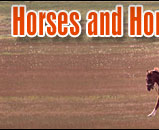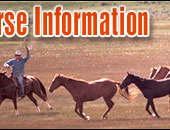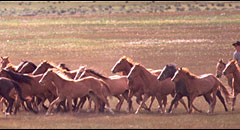 |
   |
|
|
|
You are here:
Horses
> Equestrian Sports & Activities >
Reining Equestrian Event Basics |
|
What’s Involved in Reining Equestrian Events: Cutting,
Sliding, Spins and More
Reining is the latest in equestrian sports, which date back
thousands of years to the earliest days of horse training
and competition. Xenophon, a Greek officer and horse
afficianado, wrote a fine book on horses, called "On
Horsemanship" some 350 years before the birth of Christ;
people still use his advice and philosophy when training
their horses in the basics and advanced work whether in
dressage or cutting and reining. |
|
|
Based on the American Western traditions of cattle work,
reining events demonstrate the specialized skills needed to
work with horses on the prairies and badlands in the
westward expansion of the nineteenth century. Reining as a
sport is overseen in the U.S. by the National Reining Horse
Association and The American Quarter Horse Association, both
governed by the United States Equestrian Federation. Rules
vary depending on the governing organization in the U.S.
Europe. Reining is vastly popular in Canada and Germany:
many of today's reining horse champions hail from Europe. |
Working with cattle in open areas in all weather and times of day and night
required cattle hands with horse know-how and horses trained to respond to
immediate and ever-changing needs. In cutting and herding, horses have to be
trained in the basics and niceties of changing directions fast, stopping
instantly and holding steady while the rider is working with ropes or a lariat
to lasso cattle. Horse lovers compare reining competitions to the classical
dressage still practiced, in which horses and riders have learned what were once
early forms of war moves, now elevated to high art. Like dressage, reining gives
horses the opportunity to compete and be judged on the a standard set of
extraordinary movements.
Reining competitions take place in arenas where one of ten patterns are run at a
canter by each participant. Although they vary in when moves occur, pattern
terminology includes circles, large and fast or small and slow, roll-backs,
spins, flying lead changes and sliding stops. Each movement is one that a
working ranch horse would use in its daily herding activities, brought to a high
level of precision.
Scoring is based on the perfection of the movements. Contestants start with 70
points, to which points are added or subtracted for each movement in the
pattern, marked individually on the score sheet. Circles are expected to be
perfectly round, and transitions in speed should be distinct. Flying lead
changes are judged on smoothness of change and constancy in speed.
The run down comes just before the sliding stop, with the horse running on the
long side of the arena. Sliding stops should be completed with the horse
continuing in a straight line, his back feet planted and sliding while his front
feet move forward. In a roll-back, the horse does a 180 degree turn from a
sliding stop going right into a smooth canter. The backup or reinback shows the
horse's ability to move backwards quickly, while maintaining a straight line.
In a spin, the horse plants his inside hind leg and spins in a complete circle
one or more times, coming out of the spin as smoothly as possible and leaving.
This is in marked contrast to the hesitation, where the patterns requires the
horse to stand still before continuing.
Although reining competitions use one of ten patterns, there are also freestyle
competitions, in which horse and rider demonstrate their own patterns of the
movements based on the original work of cow horses and cow boys. Reining arose
from rodeo riding, but competitions in reining involve only the skill of horse
and rider—cattle are not included in the events.
What Breed Make a Good Reining Horse?
Any horse trained to cattle work can be a reining horse. Warmbloods are the
horses most often used in reining, since they are the horses traditionally
chosen for cattle and ranch work. Quarter horses, appaloosas, palominos,
foxtrotters and paints are some of the horses used in reining. Arabians, while
fast, have usually been bred with cold-blooded draft-type horses to create the
warmbloods of today's most popular riding and reining breeds. Reining lessons
for horse and rider are available from reputable trainers.
|
Read the next horse riding sport article on
3 Day Sporting Event. |
|
|
|
|
 |
|
|
|
|
|
Horse Education
|
|
|
|
|
Horse Information Topics
|
|
|
|
|
|
|
|
Horse Business Owners
|
| |
Advertise with Us
Have your horse products or services exposed to over 27,000 of our monthly visitors.
|
|
|
|
|
|